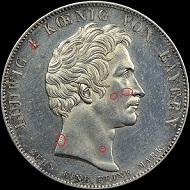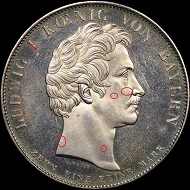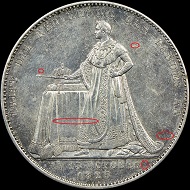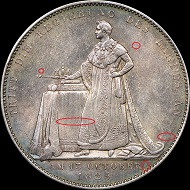December 21, 2017 – In numismatics, there is a constant battle against the proliferation of counterfeits. With technology advancing at an exponential rate, the counterfeiters are unfortunately able to more accurately replicate collectible coins.
This arms race between counterfeiters and authenticators is making the coin market an increasingly dangerous place. Most notably, there has recently been an increase in high-quality transfer die counterfeits into the marketplace. These fakes are made by essentially cloning a genuine coin. One such example of a coin that has been “cloned” in this way is the 1825 Bavaria Coronation Thaler.
The obverses of two counterfeit 1825 Bavaria Coronation Thalers.
It is clear from the photos above that these are two very different coins. There are many differing marks and scratches, and the toning is different on both. However, note the areas circled in red. These highlight marks and abrasions that are not inherent to the original design of the coin and yet are still visible on two separate examples.
Authenticators know that it is extremely unlikely for two genuine coins to have contact marks in the exact same locations, so if two coins show identical abrasions, there is a very good chance that they are fake. These recurring marks are known as “repeating depressions” and are commonly seen on transfer die counterfeits. They occur when any abrasions or imperfections on the “host” coin are transferred to the false die. These imperfections are then struck directly into every coin those counterfeit dies strike.
Sometimes it can be difficult to ascertain whether or not a mark on a coin is repeating or not without having two examples side by side. However, there are some signs that can be helpful in identifying repeaters. Often, repeating depressions are shallower than normal dings and scratches on a coin. Additionally, they will often show original mint luster inside of the marks where none would normally exist. Lastly, transfer die fakes are often cleaned by the counterfeiters in order to hide their nefarious origin, as the surfaces are not the same as the original coins.
The reverses of two counterfeit 1825 Bavaria Coronation Thalers.
The reverses of these two pieces actually have even more repeating depressions than the obverses. Note the long scratch through the tablecloth and robe that can be seen on both pieces, as well as the scratches to the right of “OCTOBER.” There are many more repeaters that were not circled on these images; the host coin must have been relatively low quality.
Transfer die counterfeits are one of the most deceptive types of counterfeit coins. The counterfeiters have focused especially heavily on 19th century German 1 and 2 Thaler coins.
To help collectors and dealers identify counterfeit and altered coins, NGC has created a comprehensive Counterfeit Detection resource.
For more NGC articles on counterfeit coins click here.
The CoinsWeekly archive has also several contributions on forgeries and their detection.








